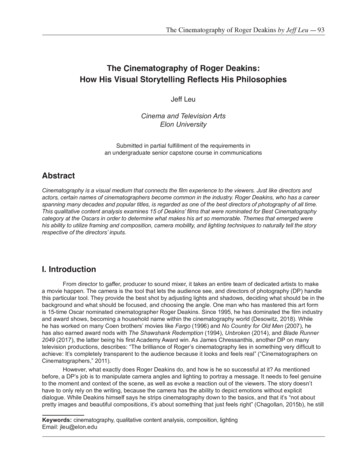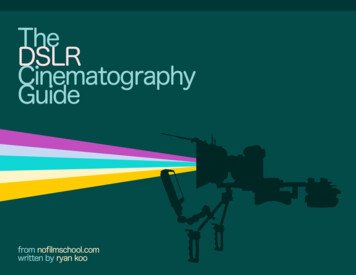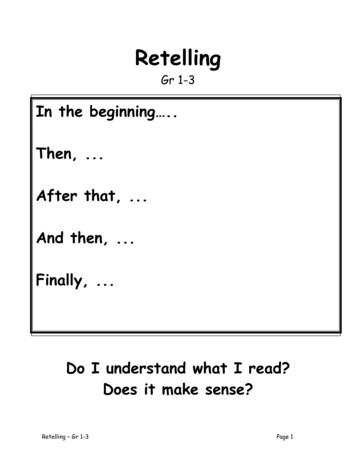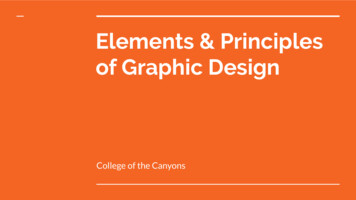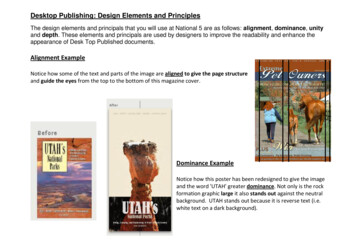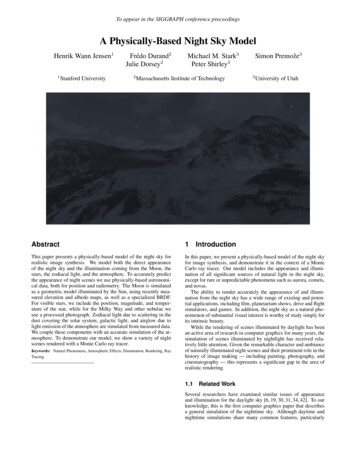
Transcription
ELEMENTS OFCinematography
Definition of Cinematography:The art or technique of movingphotography, including both theshooting and development of the film.
Camera: In film making multiple cameras(multiple camera positions of a singlecamera) are often used. In editing phase scenes/shots areassembled in a way that the story is told inan effective way.ALL RIGHTS RESERVEDNo part of this document may be reproduced without written approval from Limkokwing University College of Creative Technology
Elements of Cinematography can bedivided into: Types of shots -- shot size, cameraangle, POV, two shot, over the shouldershot. 180 degree rule Camera moves Composition rules Safe areasALL RIGHTS RESERVEDNo part of this document may be reproduced without written approval from Limkokwing University College of Creative Technology
The followings are types of shots commonlyused in film, video, and animation.ALL RIGHTS RESERVEDNo part of this document may be reproduced without written approval from Limkokwing University College of Creative Technology
Shots with different shot sizes.One of the major distinctions amongtypes of shots is the shot size. The shotsize identifies how large and area willbe visible within the frame. Among thefollowing common shot sizes thedistance between the camera andsubject variesALL RIGHTS RESERVEDNo part of this document may be reproduced without written approval from Limkokwing University College of Creative Technology
Extreme wide shot (EWS) shows a broad view of the surroundings aroundthe character and coveys scale, distance, and geographic location. Wide shot (WS) shows an entire character from head to toe. Medium wide shot (MWS) shows a character usually cut off across thelegs above or below the knees. It is wide enough to show the physicalsetting in which the action is taking place, yet it is close enough to shotfacial expression. Medium shot (MS) shows a character's upper-body, arms, and head. Close-up shot (CU) shows a character's face and shoulders. It is closeenough to show subtle facial expressions clearly. Extreme close-up shot (ECU) shows only a part of a character's face. Itfills the screen with the details of a subject.
Extreme wide shotALL RIGHTS RESERVEDNo part of this document may be reproduced without written approval from Limkokwing University College of Creative Technology
Wide shot
Medium wide shot
Medium shotALL RIGHTS RESERVEDNo part of this document may be reproduced without written approval from Limkokwing University College of Creative Technology
Close Up shotALL RIGHTS RESERVEDNo part of this document may be reproduced without written approval from Limkokwing University College of Creative Technology
The images are from "The Art of Technique: An Aesthetic Approach to Film and Video Production"by John Douglass and Glenn HarndenExtreme Close upshot
2. Shots with different camera angles.Another one of the major distinctionsamong types of shots is the cameraangle. Changing the camera anglechanges the appearance and function ofyour shot.ALL RIGHTS RESERVEDNo part of this document may be reproduced without written approval from Limkokwing University College of Creative Technology
Horizontal camera angles. Moving the camera around the subjecthorizontally while aiming at the subject createsdifferent camera angles below: Frontal. The frontal angle tends to flatten the threedimensionality of facial features and environments.Three-quarter front. The three-quarter front angle ismore often used than the frontal angle or profilebecause it shows more depth and volumes.Profile.Three-quarter rear.Rear.
Horizontal camera anglesALL RIGHTS RESERVEDNo part of this document may be reproduced without written approval from Limkokwing University College of Creative Technology
Vertical camera angles. Moving the cameraaround the subject vertically while aiming at thesubject creats different camera angles below: High angle. The camera is placed above eye level,looking downward. A high angle shot can make acharacter look smaller, younger, weak, confused, ormore childlike. Eye level. Most commonly used. Low angle. The camera is placed below eye level,looking upward. A low angle shot can make a characterlook bigger, stronger, or more noble. It also gives theimpression of height.
Vertical camera angles
High AngleLow AngleALL RIGHTS RESERVEDNo part of this document may be reproduced without written approval from Limkokwing University College of Creative Technology
POV shots. In a point of view (POV) shot, thecamera is placed at the eye position ofa character.ALL RIGHTS RESERVEDNo part of this document may be reproduced without written approval from Limkokwing University College of Creative Technology
Two shot & over-the-shoulder shot Two shot shows two characters. Over-the-shoulder shot is a close-up of acharacter as seen over-the-shoulder ofanother person in the foreground.
Two ShotOver the Shoulder shotALL RIGHTS RESERVEDNo part of this document may be reproduced without written approval from Limkokwing University College of Creative Technology
180 degree ruleIf you are using multiple cameras and plan toedit the different shots in a scene into aseamless sequence, an important rule to keep inmind is to place all the cameras on the sameside of a line of action. A line of action is a path which your subject istraveling along or an imaginary line between twocharacters who are interacting. This rule is called"180 degree rule".Look at the following camera placements:ALL RIGHTS RESERVEDNo part of this document may be reproduced without written approval from Limkokwing University College of Creative Technology
ALL RIGHTS RESERVEDNo part of this document may be reproduced without written approval from Limkokwing University College of Creative Technology
If Camera 2 and Camera 3 are used, the audience stays on one side of the line of action. These shots are called"reverse angle shots".
If Camera 2 and Camera 4 are used, the audience crosses the line of action. It's disorienting and confusing.The images are from "The Five C's of Cinematography" by Joseph V. MascelliALL RIGHTS RESERVEDNo part of this document may be reproduced without written approval from Limkokwing University College of Creative Technology
Camera movement Pan. The camera rotates from side to side, so that it aims more tothe left or right. The camera does not change the location. Tilt. The camera rotates to aim upward or downward withoutchanging the location. Tilt is sometimes called "pitch". Zoom. The camera's lens is adjusted to increase or decrease thecamera's field of view, magnifying a portion of the scene withoutmoving the camera. Dolly. The camera's actual position changes, such as to movealongside a moving subject or to travel closer to a character during ascene. Dolly in moves the camera closer to the subject. Dolly outbacks the camera away from the subject. Dolly in and dolly out aresometime called "track".
Pan
Full pan / low angle shot
Tilt Up Shot
Crane shot
Tracking shot
Tracking / Dolly shot
Steadycam shot / Hand held
The image is from "The Art of 3-D Computer Animation and Imaging" by Isaac Kerlow.ALL RIGHTS RESERVEDNo part of this document may be reproduced without written approval from Limkokwing University College of Creative Technology
Dolly vs. Zoom The difference between dolly and zoom is that whenyou dolly, you are moving the camera in space, whilezoom refers to changing the camera's focal length.When you move the camera, the perspectivechanges. Objects far from the camera change in relative size ata slower rate than objects which are close to thecamera. That is what you see through your human eyes asyou walk around, your perspective changes. On theother hand, when you zoom (i.e., when you changethe focal length of your camera), your camera doesnot move and perspective does not change.ALL RIGHTS RESERVEDNo part of this document may be reproduced without written approval from Limkokwing University College of Creative Technology
Composition Rules:The followings are useful guidelinesyou can use when composing a shotALL RIGHTS RESERVEDNo part of this document may be reproduced without written approval from Limkokwing University College of Creative Technology
1. Rule of thirdsRule of thirds dividesthe frame into thirds bothhorizontally and vertically.The points where thevertical and horizontal linescross are aestheticallypleasing spots to placesubjects or to haveperspective lines converge.It is usually best toavoid placing horizon linesexactly in the middle of aframe, but to place thehorizon either above orbelow center,approximately one-third ortwo-thirds up the height ofthe frame.ALL RIGHTS RESERVEDNo part of this document may be reproduced without written approval from Limkokwing University College of Creative Technology
2. Teeter-totter ruleLighter weight can counterbalance a heavier weight if it is placed farther away from the centerof the frame.The images are from "Digital Lighting and Rendering" by Jeremy Birn and "The Art of Technique"ALL RIGHTS RESERVEDNo part of this document may be reproduced without written approval from Limkokwing University College of Creative Technology
3. Avoid frontal angleThe frontal angle tends to flatten the three dimensionalityof facial features and environments. Angling the shot produces more depth and volumes.Shooting straight against walls producesflat compositions with little sense ofdepth in frame.Angling the shot into walls producesreceding perspectives and a bettersense of depth.
Safe AreasText, e.g., the title shouldbe kept in the center 80% ofthe screen, within a guidelinecalled the title safe area.To make sure that youraudience will not miss anyimportant action in yourvideo, the vital parts of yourscene should take placewithin the central 90% ofyour frame, a guidelinecalled the action safe area.Why? It's because what'soutside the action safe areais invisible on most TV sets.The Following notes was taken from:Http://accad.osu.edu/ midori/Materials/camera.html
setting in which the action is taking place, yet it is close enough to shot . The images are from "Digital Lighting and Rendering" by Jeremy Birn and "The Art of Technique" 2. Teeter-totter rule L
